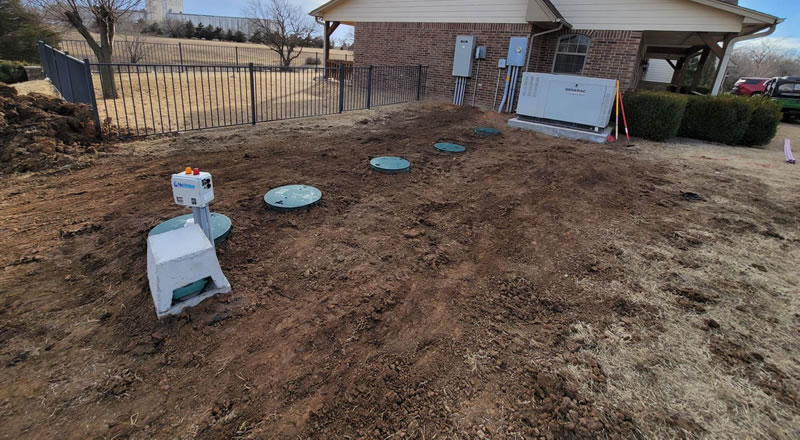Aerobic Septic System Installations

An aerobic septic system is a type of onsite wastewater treatment system that uses air and bacteria to treat and discharge household sewage. Unlike a conventional septic system that uses anaerobic bacteria to treat the wastewater, an aerobic system uses oxygen-loving bacteria to break down the organic matter in the wastewater.
Caliber Septic Service is a septic services contractor based out of Garber, OK and serving Medford, Blackwell, Ponca City, Tonkawa, Enid, Waukomis, Crescent, Covington, Marshall, Lamont, and Billings. We specialize in the installation and repair of aerobic septic systems.
Aerobic systems typically consist of a tank that holds the wastewater and a system of pumps, aerators, and filters that provide air and bacteria to the wastewater to facilitate the treatment process. The treated wastewater is then discharged into the soil, either through a drain field or a spray field.
Aerobic systems are often used in areas with poor soil conditions or high water tables, where a conventional septic system may not be feasible. They are also often preferred for their ability to treat wastewater more quickly and efficiently, resulting in clearer, cleaner discharge water.
Aerobic septic systems are used instead of conventional systems because of several benefits, including:
#1. Improved water quality: An aerobic system uses oxygen to break down waste, producing cleaner effluent.
#2. Faster treatment: The aerobic process is faster than the anaerobic process used in conventional septic systems, reducing the amount of time waste remains in the tank.
#3. Smaller footprint: Aerobic systems are smaller and require less space than conventional septic systems, making them a good choice for properties with limited space.
#4. Reduced maintenance: Aerobic systems require less maintenance than conventional systems because the aerobic process produces less sludge.
#5. Increased sustainability: Aerobic systems are more environmentally friendly than conventional systems because they use less water and produce less harmful by-products.
An aerobic septic system typically consists of the following components:
Septic tank: The septic tank serves as the primary settling and storage chamber for your wastewater.
Aerator: The aerator provides oxygen to the wastewater in the tank to facilitate the aerobic bacterial digestion process.
Pump tank: The pump tank holds the effluent that has been treated by the aerator and pumps it to the final treatment unit.
Final treatment unit: The final treatment unit is the component responsible for treating the effluent to a level that meets discharge standards. This can be a spray field, drip irrigation system, or other type of discharge system.
Control panel: The control panel operates and monitors the system, ensuring it is functioning properly.
Alarm system: An alarm system alerts the homeowner if there are any issues with the system, such as low oxygen levels or high wastewater levels in the tank.
Discharge pipe: The discharge pipe carries the treated effluent from the final treatment unit to the discharge location.
It's important to note that each county and municipality may have specific requirements for aerobic septic systems, we understand the specific requirements in each of the counties we service to ensure compliance for your aerobic septic system.
How Do You Maintain Your Aerobic Septic System?
Like any septic system, regular preventative maintenance can ensure your system performs trouble-free for many years. Here are some specific maintenance tasks to keep your aerobic septic system performing properly.
Monitor the system regularly: This can be done by checking the alarm, the air pressure gauge, and pump, and listening for any unusual sounds.
Pump the tank regularly: The septic tank should be pumped out every 1-3 years, depending on the usage and the size of the tank. We can provide you with an appropriate pumping interval after viewing your system.
Add bacteria to the tank: Aerobic septic systems require bacteria to break down waste. You may need to periodically add a commercial bacteria treatment to the tank.
Keep records: It's always a good idea to keep records of all maintenance activities, including pumping, repairs, and adding bacteria. If you're using Firestorm Septics & Shelters to maintain your system we also keep accurate records of the visits we make to your property and what has been done with your aerobic septic system.
Minimize water usage: It's always helpful to try and find ways to reduce the amount of water you use in your household. This will extend the life of the system.
Avoid using chemical drain cleaners: These types of cleaners can kill the necessary bacteria in the septic tank. It's best to avoid using them.
Do not flush non-degradable items: Only flush biodegradable items, such as human waste and toilet paper, down the toilet. Do not flush tampons, baby wipes, paper towels, cigarrette butts, and other items down the toilet or drain.
By following these steps, you can help ensure that your aerobic septic system operates effectively and lasts a long time.
Aerobic Septic System Installation and Repair In Oklahoma
If you need to have your septic drain field replaced or repaired please call (580) 548-7498 or fill out our online contact form and we will get back to you promptly.
